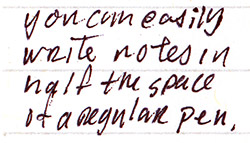Lately bloggers have been going crazy for new Japanese pens. Online vendors started importing Japanese pens so now they’re easy to get, so everyone is debating which pen is best for their purposes. Dan Sanderson over at BrainLog wrote about how he accidentally ordered a Uniball Signo Bit 0.18mm gel pen instead of the 0.28mm pen he wanted. I jokingly told him I’ve been dying to test the 0.18mm pens so if he wanted to get rid of it, I’d take it off his hands. So he sent it to me, and I’ve been playing around with it.

I think this is a great little pen, as long as you know what it’s designed for. There’s a competition amongst Japanese pen manufacturers to produce a pen with the finest tip, and the 0.18mm models are the latest and most popular products. They are popular with Japanese schoolkids, they pass notes to each other written in very tiny writing, so their eyeglass-wearing teachers can’t read them. And I immediately noticed this effect, I not only have to wear my close-vision glasses to read what I write, I have to wear my glasses just to see what I’m writing.
I’m more of an aficionado of Japanese mechanical pencils, and I’ve tested out extremely fine-point pencils before. They’re commonly used in drafting, but a 0.25mm lead is too fragile for everyday use, it breaks too easily. So I generally use a 0.5mm pencil like the Uniball Logo II 0.5mm. But a 0.25mm pencil is exceptionally useful for making tiny notes inline above a text, like furigana.
Dan described using the 0.18mm pen as like scratching the point of a pin across the paper, except it leaves ink behind. And that’s part of the problem with tiny pens and pencils, the tip is so small, it can drag and catch on the fiber of the paper. The gel ink is designed to alleviate this problem somewhat, but it still works better on smooth, glossy paper. Most Japanese notebook paper is somewhat finer quality than US paper, so I guess this is less of a problem in Japan. I have a Japanese college ruled notebook, so I tested it out, and you can see in this enlargement, it’s no problem to write two lines in the same vertical space you’d normally write one line.

Part of the problem in using a pen this small is that to write small, you must use exceptionally small muscle movements. This gives your tiny handwriting a shaky, unclear look. I have terrible handwriting anyway (as you can see from my sloppy sample above) but at even smaller sizes, it gets much worse. My Japanese handwriting is a little better, so I thought I’d try a tiny “invisible” note. It wasn’t easy, it took me a few tries to write legibly at this size, so here’s an example, it says “yomeru ka” (“can you read it?”) and I’ve reproduced it at actual size, and highly enlarged. I definitely can not read the original without my eyeglasses.

You can use this enlargement for graphical effects. There’s an old graphic artist’s trick of writing extremely small and enlarging it dramatically. This gives the text an interesting, rough texture from the ink absorbing randomly into the paper fibers. I tried it out by writing my blog’s title, I drew a “blueline,” it’s a special color of blue that can be easily removed from the final scan, but provides a guideline to keep your text straight. But this 0.18mm pen writes so small, the height of the text is barely as wide as the blueline.

Well that’s a pleasant effect, but a little bit too blobby for practical use. Maybe if I wrote on smoother paper, it would look nicer. But my handwriting is so poor, I’m unlikely to improve on it. And there’s the problem with this 0.18mm pen, it magnifies all the flaws in your writing, you have to wield the pen with exceptional skill. I’d rather use a small mechanical pencil, at least I can erase and redo it if I make a sloppy mistake. And I make lots of mistakes.
Ultimately, I can’t recommend this 0.18mm pen for general use, it is rather specialized, but it is very good at the job it is intended for. The 0.28mm version might be better for general writing, but I don’t have one to test, and some reviewers have complained that even the 0.38mm version is too fine. But if you need to write tiny notes, perhaps margin notes in a book, or furigana, this pen is the best I’ve ever used.
Is this the ultimate limit of pen technology? Of course not, there are finer pens like the Rapidograph 6×0 0.13mm pen, but it’s a drafting pen, it clogs easily and requires constant maintenance. The Uniball gel ballpoint pens don’t require any maintenance. So I am sure that smaller, finer ballpoints will be produced, I’ve already heard rumors of a 0.125mm pen. But just how fine a line do you really need? The 0.18mm is already so fine it is almost invisible.
Uniball Signo Bit 0.18mm Pen
Uniball Signo bit, 0.18mm pen, pen, pen review
A few years ago when I was in high school, I got an even finer gel pen: a Pentel 0.1mm tip gel pen. The tip is so fine that not only it caught on rough paper fibres and get clogged easily, but the tip get smashed easily as well. You would never want to drop it, a small shift of a few degrees would be good enough to stop it flowing at all!
The pen is called Pentel Energel Liquid Gel Pen 0.1mm
Nice. I’ve used some of the fine Rapidograph pens like the 4×0 but never anything as fine as the 6×0 .13mm. It was really easy to bend the tip even on the 4×0 pens, it takes an exceptionally fine touch. –Charles]